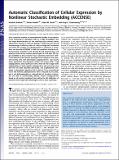Automatic Classification of Cellular Expression by Nonlinear Stochastic Embedding (ACCENSE)
Author(s)
Shekhar, Karthik; Brodin, Petter; Davis, Mark M.; Chakraborty, Arup K
DownloadShekhar-2014-Automatic Classifica.pdf (1.144Mb)
PUBLISHER_POLICY
Publisher Policy
Article is made available in accordance with the publisher's policy and may be subject to US copyright law. Please refer to the publisher's site for terms of use.
Terms of use
Metadata
Show full item recordAbstract
Mass cytometry enables an unprecedented number of parameters to be measured in individual cells at a high throughput, but the large dimensionality of the resulting data severely limits approaches relying on manual “gating.” Clustering cells based on phenotypic similarity comes at a loss of single-cell resolution and often the number of subpopulations is unknown a priori. Here we describe ACCENSE, a tool that combines nonlinear dimensionality reduction with density-based partitioning, and displays multivariate cellular phenotypes on a 2D plot. We apply ACCENSE to 35-parameter mass cytometry data from CD8+ T cells derived from specific pathogen-free and germ-free mice, and stratify cells into phenotypic subpopulations. Our results show significant heterogeneity within the known CD8+ T-cell subpopulations, and of particular note is that we find a large novel subpopulation in both specific pathogen-free and germ-free mice that has not been described previously. This subpopulation possesses a phenotypic signature that is distinct from conventional naive and memory subpopulations when analyzed by ACCENSE, but is not distinguishable on a biaxial plot of standard markers. We are able to automatically identify cellular subpopulations based on all proteins analyzed, thus aiding the full utilization of powerful new single-cell technologies such as mass cytometry.
Date issued
2014-01Department
Massachusetts Institute of Technology. Institute for Medical Engineering & Science; Massachusetts Institute of Technology. Department of Biological Engineering; Massachusetts Institute of Technology. Department of Chemical Engineering; Massachusetts Institute of Technology. Department of Chemistry; Massachusetts Institute of Technology. Department of Physics; Ragon Institute of MGH, MIT and HarvardJournal
Proceedings of the National Academy of Sciences
Publisher
National Academy of Sciences (U.S.)
Citation
Shekhar, K., P. Brodin, M. M. Davis, and A. K. Chakraborty. “Automatic Classification of Cellular Expression by Nonlinear Stochastic Embedding (ACCENSE).” Proceedings of the National Academy of Sciences 111, no. 1 (December 16, 2013): 202–207.
Version: Final published version
ISSN
0027-8424
1091-6490